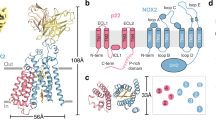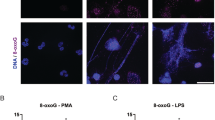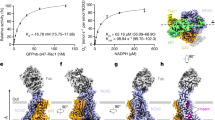Abstract
PROFESSIONAL phagocytes, such as neutrophils and monocytes, have an NADPH oxidase that generates superoxide and other reduced oxygen species important in killing microorganisms (reviewed in ref. 1). Several components of the oxidase complex have been identified as targets of genetic defects causing chronic granulomatous disease2–4. The complex consists of an electron transport chain that has as its substrate cytosolic NADPH and which discharges superoxide into the cavity of the intracellular phagocytic vacuole. The only electron transport component identified so far is a low-potential cytochrome b (refs 5,6), apparently the only membrane component required7. At least three cytosolic factors are also necessary, two of which, p67phox and p47phox, have been identified by their absence in patients with chronic granulomatous disease8–11. A third component, ω1 (refs 12, 13), is required for stimulation of oxidase activity in a cell-free system14–16. The active components of purified ω1 are two proteins that associate as heterodimers17, and here we report that these are the small GTP-binding protein p21racl and the GDP-dissociation inhibitor rhoGDI.
This is a preview of subscription content, access via your institution
Access options
Subscribe to this journal
Receive 51 print issues and online access
$199.00 per year
only $3.90 per issue
Buy this article
- Purchase on Springer Link
- Instant access to full article PDF
Prices may be subject to local taxes which are calculated during checkout
Similar content being viewed by others
References
Segal, A. W. J. clin. Invest. 83, 1785–1793 (1989).
Quie, P. G., White, J. G., Holmes, B. & Good, R. A. J. clin. Invest. 46, 668–679 (1967).
Segal, A. W. et al. New Engl. J. Med. 308, 245–251 (1983).
Clark, R. A. et al. New Engl. J. Med. 321, 647–652 (1989).
Segal, A. W. & Jones, O. T. G. Nature 276, 515–517 (1978).
Cross, A. R., Jones, O. T. G., Harper, A. M. & Segal, A. W. Biochem. J. 194, 599–606 (1981).
Knoller, S., Shpungin, S. & Pick, E. J. biol. Chem. 266, 2795–2804 (1991).
Segal, A. W., Heyworth, P. G., Cockcroft, S. & Barrowman, M. M. Nature 316, 547–549 (1985).
Volpp, B. D., Nauseef, W. M. & Clark, R. A. Science 242, 1295–1297 (1988).
Nunoi, H., Rotrosen, D., Gallin, J. I. & Malech, H. L. Science 242, 1298–1301 (1988).
Leto, T. L. et al. Science 248, 727–730 (1990).
Pick, E., Kroizman, T. & Abo, A. J. Immun. 143, 4180–4187 (1989).
Sha'ag, D. & Pick, E. Biochim. biophys. Acta 1037, 405–412 (1990).
Bromberg, Y. & Pick, E. Cell. Immun. 88, 213–221 (1984).
Heyneman, R. A. & Vercauteren, R. E. J. Leuk. Biol. 36, 751–759 (1984).
Bromberg, Y. & Pick, E. J. biol. Chem. 260, 13539–13545 (1985).
Abo, A. & Pick, E. J. biol. Chem. (in the press).
Didsbury, J., Weber, R. F., Bokoch, G. W., Evans, T. & Snyderman, R. J. J. biol. Chem. 264, 16378–16382 (1989).
Fukumoto, Y. et al. Oncogene 5, 1321–1328 (1990).
Seifert, R., Rosenthal, W. & Schultz, G. FEBS Lett. 205, 161–165 (1986).
Gabig, T. G., English, D., Akard, L. P. & Schell, M. J. J biol. Chem. 262, 1685–1690 (1987).
Ligeti, E., Doussiere, J. & Vignais, P. V. Biochemistry 27, 193–200 (1988).
Aharoni, I. & Pick, E. J. Leuk. Biol. 48, 107–115 (1990).
Eklund, E. A., Marshall, M., Gibbs, J. B., Crean, C. D. & Gabig, T. G. J. biol. Chem. 280, 13964–13970 (1991).
Quinn, M. T. et al. Nature 342, 198–200 (1989).
Hori, Y. et al. Oncogene 6, 515–522 (1991).
Isomura, M., Kikuchi, A., Ohga, N. & Takai, Y. Oncogene 6, 119–124 (1991).
Chardin, P. et al. EMBO J. 8, 1087–1092 (1989).
Paterson, H. F. et al. J. Cell Biol. 111, 1001–1007 (1990).
Rodaway, A. R. F., Teahan, C. G., Casimir, C. M., Segal, A. W. & Bentley, D. L. Molec. cell. Biol. 10, 5388–5396 (1990).
Lomax, K. J., Leto, T. L., Nunoi, H., Gallin, J. I. & Malech, H. J. Science 245, 987 (1989).
Volpp, B. D., Nauseef, W. M., Donelson, J. E., Moser, D. R. & Clark, R. A. Proc. natn. Acad. Sci. U.S.A. 86, 9563 (1989).
Drubin, D. G., Mulholland, J., Zhu, Z. & Botstein, D. Nature 343, 288–290 (1990).
Woodman, R. C. et al. J. clin. Invest. 87, 1345–1351 (1991).
Clark, R. A., Volpp, B. D., Leidal, K. G. & Nauseef, W. M. J. clin. Invest. 85, 714–721 (1990).
Pick, E. & Keisari, Y. Cell. Immun. 59, 301–318 (1981).
Diekmann, D. et al. Nature 351, 400–402 (1991).
Pick, E., Bromberg, Y., Shpungin, S. & Gadba, R. J. J. biol. Chem. 262, 16476–16483 (1987).
Hall, A. & Self, A. J. J. biol. Chem. 261, 10963–10965 (1986).
Author information
Authors and Affiliations
Rights and permissions
About this article
Cite this article
Abo, A., Pick, E., Hall, A. et al. Activation of the NADPH oxidase involves the small GTP-binding protein p21rac1. Nature 353, 668–670 (1991). https://doi.org/10.1038/353668a0
Received:
Accepted:
Issue Date:
DOI: https://doi.org/10.1038/353668a0
This article is cited by
-
Rac1 deficiency impairs postnatal development of the renal papilla
Scientific Reports (2022)
Comments
By submitting a comment you agree to abide by our Terms and Community Guidelines. If you find something abusive or that does not comply with our terms or guidelines please flag it as inappropriate.



